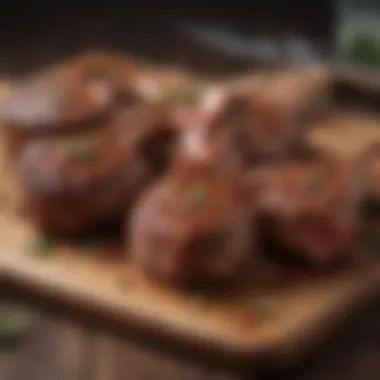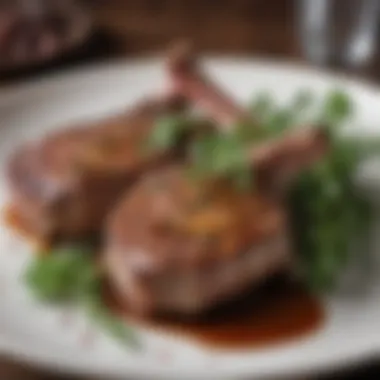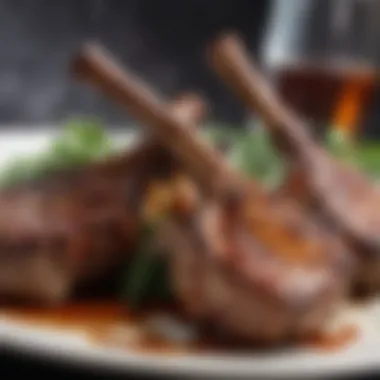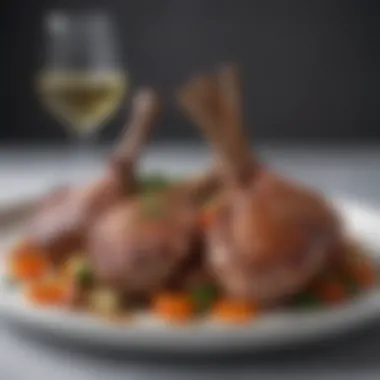Mastering Shoulder Lamb Chops: Techniques & Flavors


Intro
Cooking shoulder lamb chops can transform an ordinary meal into an extraordinary culinary experience. This unique cut, taken from the shoulder of the lamb, stands out for its rich flavor and versatility. Understanding the nuances of preparation and cooking can elevate your dish.
In this guide, we will explore essential techniques, selection tips, and flavor profiles that harmonize well with shoulder lamb chops. The aim is to provide both novice and experienced cooks with the tools they need to craft a memorable dish.
Recipe Overview
Recipe Name and Description
Shoulder Lamb Chops with Herb Marinade
This dish features shoulder lamb chops marinated in a blend of fresh herbs, garlic, and olive oil. The marinade not only enhances the flavor but also tenderizes the meat, making it succulent and juicy. A perfect choice for a family gathering or dinner party.
Cuisine Type
Mediterranean
This recipe draws inspiration from Mediterranean cuisine, where lamb is a central ingredient. The fresh herbs and simple preparation methods shine through, emphasizing a balance between robust flavors and the natural quality of the meat.
Ingredients List
Detailed Ingredient Breakdown
- Shoulder Lamb Chops: 4 pieces, bone-in, about 1 inch thick
- Fresh Rosemary: 2 tablespoons, finely chopped
- Fresh Thyme: 2 tablespoons, finely chopped
- Garlic: 4 cloves, minced
- Olive Oil: 1/4 cup
- Salt: 1 teaspoon
- Black Pepper: 1/2 teaspoon
- Lemon Juice: From 1 lemon
Substitutions for Dietary Needs
- Herbs: If rosemary and thyme are not available, use dried oregano or parsley.
- Olive Oil: Substitute with avocado oil for a different flavor profile.
- Lemon Juice: Use vinegar, such as apple cider vinegar, if lemon is not on hand.
"Marinating shoulder lamb chops not only boosts flavor but can significantly enhance the texture and juiciness of the meat."
Understanding these key components will set the foundation for crafting a delicious meal. The careful selection of ingredients and proper cooking techniques reflect an appreciation for quality food. The journey does not end here; let's delve deeper into preparation techniques and flavor pairings.
Understanding Shoulder Lamb Chops
Shoulder lamb chops present a unique opportunity for culinary exploration. Understanding their characteristics, nutritional benefits, and variations can significantly enhance your cooking capabilities. This section lays the groundwork for appreciating this specific cut of meat, which is often overlooked in favor of more popular parts such as the loin or rack. Knowing about shoulder lamb chops allows anyone to produce rich, flavorful dishes that showcase the potential of this meat, inviting both novice cooks and experienced chefs to experiment.
Definition and Characteristics
Shoulder lamb chops are cut from the shoulder area of the lamb, a region that features significant muscle and fat. They typically possess a hearty flavor profile that is distinctively gamier than other cuts. The chops can be bone-in or boneless, with the former often yielding more flavor and rich juiciness during cooking. Their marbling and intermuscular fat contribute to a tender and succulent texture when cooked correctly, making them ideal for methods that require longer cooking times or good seasoning.
Nutritional Profile
Lamb is not only known for its bold flavors but also its high nutritional value. Shoulder lamb chops are a source of high-quality protein, essential vitamins, like B12, and important minerals such as zinc and iron. A standard serving provides around 20-25 grams of protein, vital for muscle maintenance and recovery. Additionally, they may contain omega-3 and omega-6 fatty acids, contributing to heart health. However, being mindful of portion sizes is essential as these chops can also be higher in fat compared to other cuts, which may be a consideration for those managing dietary intakes.
Cut Variations
When it comes to shoulder lamb chops, cut variations can affect both flavor and cooking method. The primary variations include:
- Blade Chops: These are cut from the shoulder blade and often contain more fat. They are robust in flavor and remain juicy when cooked.
- Arm Chops: Taken from the arm of the shoulder, these chops generally have less marbling but are still rich in taste.
- Boneless Shoulders: These cuts are versatile and can be grilled, braised, or used in stews. They require careful cooking to maintain tenderness.
In essence, knowing the specifics of each variation lets the cook select the most appropriate chop for their intended method of preparation. This understanding not only improves the cooking experience but also elevates the final dish.
Selecting Quality Shoulder Lamb Chops
Selecting quality shoulder lamb chops is crucial for both flavor and texture. The right choice can elevate your dish, making it memorable. Proper selection ensures that you enjoy lamb that is tender, flavorful, and a delight to your palate. Factors such as meat color, marbling, and freshness should be considered. Moreover, understanding how to source them can make a difference in your overall cooking experience.
Factors to Consider
When selecting shoulder lamb chops, several factors should come into play. First, look for meat that is a bright red color. This indicates freshness. If the meat has a brown hue, it may be older and less flavorful. Next, examine the fat content. A good amount of marbling is essential, as fat contributes to the richness and juiciness of the meat.
Some other elements to keep in mind include:
- Bone Structure: The shape of the bone can indicate the age of the lamb. A more pronounced bone typically suggests a younger animal, which is preferable for tenderness.
- Packaging Date: Always check the packaging for a butcher's date to ensure freshness.
- Odor: Fresh lamb should have a mild, pleasant scent. An off-putting smell is a red flag.
Sourcing from Local Butchers
Sourcing from local butchers can lead you to higher quality shoulder lamb chops. Local butchers often offer meat that has been handled with care. Establishing a relationship with them may lead to valuable insight about the origin of their meat and how it was raised. Many local butchers support sustainable farming practices, which can enhance the quality of the meat they sell. When you buy from these sources, you can often ask for specific cuts or recommendations, providing a personalized purchasing experience.
In addition to quality, local butchers are more likely to provide fresh rather than frozen meat. This can significantly impact the taste and texture of your cooked dish.
Organic vs. Conventional Meat
When choosing between organic and conventional lamb, the decision often lies in personal preference and values. Organic lamb typically comes from animals that are raised without antibiotics or growth hormones. They are often grass-fed, which can result in a flavor profile that is richer and more robust. Additionally, organic practices can be better for the environment.
Conventional lamb, on the other hand, tends to be more widely available and generally less expensive. However, it may contain additives that can affect the taste and health benefits of the meat. If you choose conventional, trying to find a supplier that prioritizes ethical farming practices can help bridge the gap.
In summary, selecting quality shoulder lamb chops requires attention to various factors. Whether you prefer organic or conventional meat, always prioritize freshness and sourcing from reliable sources to enhance your culinary endeavors.
Preparation Techniques for Shoulder Lamb Chops
Preparation techniques are critical when it comes to shoulder lamb chops. These methods can greatly enhance the flavor and tenderness of the meat. They involve several steps, including marinating, trimming, and seasoning. Each step requires careful attention to detail to ensure the final dish is enjoyable. In this section, we will explore the benefits of marinating, the correct ways to trim and prepare the meat, and how to make seasonings that go beyond the basics.
Marinating: Benefits and Methods
Marinating is a fundamental technique that aids in flavor infusion and tenderization. It is particularly important for shoulder lamb chops, as this cut can be tougher than more expensive cuts. A good marinade can consist of various elements such as acids, oils, herbs, and spices.
Benefits of Marinating Include:


- Flavor Enhancement: A well-crafted marinade allows the meat to absorb flavors deeply. It can accentuate the natural richness of lamb.
- Tenderization: Acids in marinated, such as lemon juice or vinegar, break down muscle fibers, making the meat softer.
- Moisture Retention: Marinades add moisture, which prevents the lamb from drying out during cooking.
Methods:
- Choose a base: Consider yogurt, soy sauce, or citrus juice for depth.
- Add herbs: Rosemary and thyme are excellent choices for lamb.
- Involve spices: Cumin, coriander, or paprika can introduce warmth.
- Mix and coat: Combine all ingredients and coat the chops evenly.
- Rest: Allow the lamb to marinate in the refrigerator for at least one hour, but overnight is preferable for best results.
Trimming and Preparing the Meat
Trimming is an essential preparation technique for shoulder lamb chops. Properly prepared meat not only improves the aesthetic appearance of your dish but also enhances flavor and eating experience. Excess fat should be carefully trimmed, as it can cause flare-ups and an unpleasant texture when cooked.
Steps for Trimming:
- Use a sharp knife for precision.
- Begin at one end of the chop, gently scrape the fat without cutting into the meat.
- Aim to remove any silverskin, which can be tough and chewy.
Preparing the Meat:
- After trimming, pat each chop dry with paper towels. This step is crucial for a good sear and to prevent steaming.
- Let the meat sit at room temperature for about 30 minutes before cooking. This helps it cook evenly, avoiding cold centers.
Seasoning Beyond Salt and Pepper
Seasoning goes well beyond just using salt and pepper, especially for shoulder lamb chops. While these basic seasonings are important, more complex flavors can elevate your dish significantly.
Consider Using:
- Dry rubs: Combine spices like garlic powder, onion powder, and herbs for a robust flavor.
- Citrus Zest: Lemon or orange zest can brighten the dish and enhance lamb's natural taste.
- Flavor Infusions: Creating a paste with garlic, rosemary, and oil can add a delightful layer when rubbed onto the chops before cooking.
- Finishing Touches: After cooking, consider a drizzle of balsamic glaze or a sprinkle of fresh herbs for an enticing final presentation.
"Effective preparation techniques set the foundation for successful lamb dishes and allow flavors to reach their fullest potential."
By focusing on proper preparation techniques, you will ensure that your shoulder lamb chops not only taste good but also provide an enjoyable experience when served.
Cooking Methods for Shoulder Lamb Chops
In the context of cooking shoulder lamb chops, the method employed plays a significant role in determining the final taste, texture, and overall eating experience. Each cooking technique brings out different aspects of the meat, thus highlighting its unique flavor profile. Understanding these methods allows cooks to adapt their approach based on personal preference and desired outcome.
When preparing shoulder lamb chops, several key methods are popular. Grilling, roasting, braising, and pan-searing are traditional techniques that offer distinct advantages. Each method can enhance the taste and tenderness of the meat in specific ways while also aligning with various cuisines and meal styles.
Embracing these techniques means more than just following a list of steps; it’s about understanding the relationship between heat application and meat composition. This knowledge empowers cooks to achieve a perfect balance between moisture retention and flavor infusion. Below, we explore each method:
Grilling Techniques
Grilling is a classic technique for cooking shoulder lamb chops, allowing for the development of a rich, charred exterior that complements the natural flavors of the meat. A few essential tips can make a difference:
- Preheat the grill: Ensure the grill is hot before placing the chops on it. This helps achieve better searing and prevents sticking.
- Marinade choices: Use both acidic and oil-based marinades. Yogurt and lemon juice can tenderize the meat while enhancing taste.
- Don’t overcrowd: Give each chop enough space on the grill. Crowding leads to inconsistent cooking.
Cooking times can vary based on thickness. A good rule is to aim for about 4-5 minutes per side for medium-rare.
Roasting Methods
Roasting shoulder lamb chops is an excellent way to prepare them for larger gatherings. This method allows for even cooking at lower temperatures, resulting in juicy and flavorful chops. Key considerations include:
- Oven preheating: The oven should be preheated to around 350°F (175°C) before placing the meat inside.
- Using a roasting rack: A rack helps circulate heat around the meat, promoting even cooking.
- Resting the meat: Allow the chops to rest for at least 10-15 minutes after roasting. This step is crucial for retaining juices when slicing.
Depending on thickness, roasting can take anywhere from 25-45 minutes.
Braising for Tenderness
Braising is a slow cooking method that combines both moist and dry heat, making it ideal for shoulder lamb chops. This technique progressively breaks down tougher fibers, resulting in wonderfully tender meat. When braising, follow these steps:
- Searing first: Start by searing the chops in a hot pan with oil. This adds depth of flavor.
- Adding liquid: Once seared, introduce liquid such as broth, wine, or a mixture. Ensure it covers at least half of the meat.
- Low and slow: Allow it to cook on low heat for several hours until tender. This slow approach can transform tough cuts into flavorful dishes.
Pan-Seering: Tips for Success
Pan-searing is an efficient method that, when done correctly, can yield great results. It captures the essence of shoulder lamb chops quickly while preserving juiciness. Focus on these tips:
- Use a heavy skillet: A cast-iron or stainless-steel skillet is recommended for optimal heat retention and even cooking.
- Oil choice: Opt for oils with high smoke points, such as canola or avocado oil, to avoid burning.
- Thick chops: Choose thicker cuts as they can withstand the high heat without becoming overcooked.
Pan-searing typically takes about 3-5 minutes per side, depending on thickness, achieving a nice brown crust.
Timing and Temperature Considerations
Timing and temperature play a crucial role in the cooking process of shoulder lamb chops. This understanding not only affects the outcome in terms of taste and texture but also impacts food safety. Different methods of cooking demand different times, which often corresponds to the texture and flavor profile desired from the meat. An incorrect cooking time may result in either dry, overcooked meat or undercooked, potentially unsafe portions.
Understanding Doneness Levels
The doneness level of shoulder lamb chops directly affects their flavor and juiciness. Cooking lamb requires attention to detail, as its optimal doneness varies from medium-rare to medium well. Here are the general guidelines:
- Medium-rare: 145°F (63°C) - The meat retains a rosy center, providing a succulent experience.
- Medium: 160°F (71°C) - The pink diminishes but still offers a tender bite; a little more firm than medium-rare.
- Medium well: 165°F (74°C) - Cooked through with very little pink; the texture becomes firmer and a bit drier.
Properly assessing doneness requires familiarity with these temperatures. Undercooking lamb can lead to an unsafe meal, while overcooking removes much of the rich flavor and tender pores that shoulder lamb chops provide.
Utilizing a Meat Thermometer
A meat thermometer is an essential tool for ensuring that shoulder lamb chops reach the right doneness. When using a meat thermometer, insert it into the thickest part of the meat, avoiding any bones, which can give a false reading.
Benefits of using a meat thermometer include:


- Accuracy: It provides precise readings, allowing cooks to avoid guesswork.
- Consistency: Each chop can be cooked to the same internal temperature, resulting in a balanced dish.
- Safety: It helps ensure that the meat reaches a safe temperature, minimizing risks of foodborne illness.
Flavor Pairings with Shoulder Lamb Chops
Flavor pairings with shoulder lamb chops are crucial for elevating the dish. The right combinations can enhance the natural richness of the lamb while providing contrasting or complementary taste elements. Each pairing should consider the unique flavor profile of lamb, which is often robust and slightly gamey. Understanding these elements allows chefs and home cooks alike to create a well-rounded meal that delights the palate.
Herbal Combinations
Herbs are a cornerstone in seasoning lamb. Rosemary, thyme, and oregano are particularly effective. Their earthiness complements the lamb's flavor without overwhelming it. Rosemary, with its pine-like aroma, adds a fresh aspect. Thyme contributes a subtle complexity, while oregano introduces a hint of warmth.
When preparing your lamb chops, consider making a herb crust. A mixture of chopped herbs, breadcrumbs, and olive oil can create a pleasing texture and flavor. Additionally, marinating the lamb in a blend of these herbs with garlic helps to infuse the meat deeply.
Spicy Additions and Complements
For those who enjoy a bit of heat, utilizing spices can take shoulder lamb chops to another level. Spices like cumin, coriander, and paprika can introduce warmth and depth. Cumin's nutty flavor works well with the richness of lamb. Coriander, offering a citrusy note, can balance the heaviness of the meat. Paprika can add both color and a mild to moderate spice, depending on the type used.
One method is to create a spice rub before cooking. Combine these spices with salt, pepper, and perhaps a dash of cayenne for extra kick. This rub can be applied either before grilling or roasting, allowing the flavors to meld with the meat.
Fruity Accompaniments
Fruits can provide a refreshing counterpoint to shoulder lamb chops. Ingredients such as apricots, figs, and pomegranate are excellent choices. Their natural sweetness pairs well with the savory notes of lamb, creating a balance that is pleasing to the tongue and eye.
Incorporating these fruits can be done in various ways. Adding a fruity salsa on top of grilled lamb enhances texture and flavor complexity. Alternatively, a glaze made from reduced fruit juices can add a shiny finish while infusing extra taste. Pairing lamb with a side of roasted vegetables and a fruit component makes for a harmonious plate.
Overall, knowing how to pair flavors effectively can drastically impact the dining experience when serving shoulder lamb chops.
By combining these elements thoughtfully, any cook can elevate shoulder lamb chops from a simple dish to a memorable meal.
Serving Suggestions
Serving suggestions play a crucial role in enhancing the dining experience when it comes to shoulder lamb chops. The presentation and pairing of this dish can elevate its overall appeal. It is essential to choose side dishes that complement the richness of the lamb. A well-thought-out selection can create a balanced meal, offering a variety of textures and flavors that highlight the lamb's unique characteristics.
The importance of side dishes cannot be overstated. They should not only accompany the lamb but also provide contrast or support to the main dish. From traditional staples to modern inventive pairings, how you serve your shoulder lamb chops makes a significant difference. This section will explore both traditional and modern accompaniments to consider when serving shoulder lamb chops.
Traditional Side Dishes
Traditional side dishes often reflect cultural influences and can be deeply tied to family recipes. For shoulder lamb chops, classic options include:
- Roasted Vegetables: Carrots, potatoes, and onions roasted with herbs provide a great balance to the meat.
- Mint Sauce: A staple in many lamb dishes; the fresh taste of mint cuts through the richness of the fat.
- Mashed Potatoes: Creamy and buttery, they serve as a comforting base.
- Couscous: Often seasoned with lemon and herbs, it can absorb flavors well and add a light touch to the meal.
- Green Beans Almondine: Crisp green beans tossed with toasted almonds offer a pleasant crunch.
These dishes not only provide a familiar comfort but also enhance the flavor of the lamb. It's important to prepare these sides in a way that retains their individual character while blending harmoniously with the lamb.
Modern Accompaniments
Modern dishes can add a fresh twist to your serving suggestions. Here are some ideas:
- Quinoa Salad: A healthy option with fresh vegetables and a light dressing can add a nutritious element.
- Roasted Beet Salad: The earthiness of beets with feta cheese can create a beautiful visual and a flavor contrast.
- Grilled Asparagus: Charred and seasoned, these bright-green stalks add a modern touch to the plate.
- Sweet Potato Mash: With a slightly sweet flavor, this dish harmonizes well with the saltiness of the lamb.
- Pesto Pasta: Light pasta dressed with pesto brings a contemporary flair that pairs nicely with lamb.
Mixing traditional and modern accompaniments can provide a delightful surprise to your guests, showcasing innovation while respecting classic flavors.
Choosing the right combinations for shoulder lamb chops enhances not just the meal but the entire dining experience. With careful consideration of flavors and presentation, it allows you to elevate a simple dinner into a memorable feast.
Storing Leftover Shoulder Lamb Chops
Storing leftover shoulder lamb chops is vital for maintaining both the quality and the flavor of the meat. Proper storage prevents spoilage and helps ensure that the initial culinary experience can be replicated at a later time. This section will address effective practices for refrigeration and freezing, ensuring that each bite remains as delectable as the first.
Refrigeration Practices
When it comes to refrigeration, the goal is to keep the shoulder lamb chops fresh and safe to eat. After enjoying a meal, make sure to handle the leftovers promptly. Here are some recommended practices:
- Cool Down Quickly: Let the cooked lamb chops cool to room temperature for no more than two hours before refrigerating. Placing them in the refrigerator while still warm can raise the internal temperature of the fridge, promoting bacterial growth.
- Use Airtight Containers: Store the leftover lamb in airtight containers. This will reduce exposure to air, which can lead to dry meat. Vacuum-sealing is also an effective option.
- Layer with Paper Towels: If stacking multiple pieces, consider placing a paper towel in between layers. This absorbs excess moisture, preventing unwanted sogginess during storage.
- Label and Date: Make sure to label the containers with the date of storage. This helps in keeping track of how long the leftovers have been there, ensuring safe consumption within the recommended time frame.
Generally, leftover shoulder lamb chops can be refrigerated for three to four days. After that period, the risk of spoilage increases significantly.
Freezing Techniques and Guidelines
Freezing is an excellent method for long-term storage of leftover shoulder lamb chops. It preserves the flavors and textures much better than refrigeration when done correctly. Here are some guidelines for freezing:
- Freeze Promptly: Like refrigeration, freezing should be done soon after the meat has cooled down. Do not leave lamb chops at room temperature for extended periods.
- Wrap Tightly: Use aluminum foil, freezer paper, or plastic wrap to securely wrap individual pieces or portions. The goal is to limit exposure to air, which can lead to freezer burn.
- Use Freezer-Safe Bags: After wrapping, place the lamb chops in freezer-safe bags. Squeeze out excess air before sealing to enhance preservation.
- Portion Sizes: Consider freezing the meat in portion sizes. This way, you only need to thaw what you plan to use, keeping the rest frozen and fresh.
- Label Clearly: Just as with refrigeration, label the packaging with the date and contents. This facilitates organization in the freezer.
Shoulder lamb chops can be frozen for up to six months without significant loss in quality. Utilizing these methods ensures that leftovers remain palatable when ready to be reheated and savored once again.
Common Mistakes to Avoid
When cooking shoulder lamb chops, avoiding common mistakes can significantly enhance the final dish. Many cooks often overlook essential techniques or concepts that can be the difference between a dry, chewy chop and a tender, flavorful piece of meat. This section will focus on two prevalent pitfalls: overcooking the meat and underestimating resting times.
Overcooking and Its Consequences
Overcooking is arguably the most common mistake people make when preparing lamb chops. Lamb has a unique flavor and texture that can be compromised if cooked for too long. The ideal doneness for shoulder lamb chops is medium-rare to medium, which retains moisture and tenderness. When the meat exceeds 145°F (63°C), it begins to dry out, resulting in a less satisfying meal.
To avoid overcooking, use a reliable meat thermometer. This tool allows you to monitor the internal temperature accurately. Once the lamb reaches the target temperature, remove it from heat immediately. Here are some key points to remember about overcooking:
- Lamb's flavor peaks at a specific doneness.
- Tough texture emerges beyond medium tenderness.
- Monitoring temperature ensures juiciness.
Incorporating timing into your cooking routine will also help prevent this mistake. Cooking shoulder lamb chops usually takes only a few minutes, depending on the method. Being attentive to the cooking process is essential.


"Timing is as crucial as the quality of the meat. It can make or break your dish."
Underestimating Resting Times
After cooking shoulder lamb chops, many cooks are eager to serve them immediately. However, underestimating resting times can negatively impact the dish. Resting allows the fibers in the meat to relax and redistribute juices after cooking, resulting in a more tender cut. If you cut into it too soon, juices will run out, leading to a dry chop.
The recommended resting time for shoulder lamb chops is about 5 to 10 minutes. This pause is vital for reabsorbing moisture, making each bite more succulent. Here are several points to consider regarding resting:
- Resting prevents juice loss during cutting.
- Enhances overall flavor and texture.
- Improves the dining experience for your guests.
In summary, avoiding common mistakes such as overcooking and underestimating resting times will enhance the quality of your shoulder lamb chops. Paying attention to these details not only improves the cooking process but also elevates the overall dining experience.
It is this mindfulness in preparation that equips cooks of all skill levels to master the art of cooking shoulder lamb chops.
Exploring Global Variations
Understanding global variations in cooking shoulder lamb chops provides a glimpse into the diverse culinary practices around the world. It allows cooks to appreciate how different cultures elevate this meat through unique flavor profiles and techniques. By exploring Mediterranean and Asian influences, for instance, one can uncover a variety of ingredients and cooking methods that transform the same cut of meat into distinctly different dishes. This exploration not only enriches the cooking experience but also invites creativity in flavor combinations.
Mediterranean Influences
Mediterranean cooking often celebrates bold flavors, which perfectly complements shoulder lamb chops. The use of herbs such as oregano, rosemary, and thyme enhances the natural taste of the lamb. Marinating the chops in a mixture of olive oil, garlic, and lemon juice is a common practice. This technique tenderizes the meat while infusing it with freshness.
In regions like Greece, lamb is often prepared with yogurt and spices, creating a tangy and aromatic dish. For instance, dishes such as lamb souvlaki or slow-cooked lamb with tomatoes and olives showcase how Mediterranean ingredients can elevate shoulder lamb chops.
Consider these important elements when cooking shoulder lamb chops with a Mediterranean influence:
- Use high-quality olive oil for marinating.
- Incorporate fresh herbs to enhance flavor.
- Serve with sides like roasted vegetables or tzatziki to complement the meal.
Asian Flavors and Techniques
Asian cuisine brings a different approach to shoulder lamb chops, emphasizing umami and aromatic balancing. Ingredients such as soy sauce, ginger, and garlic are central to marinating the meat. In countries like China, lamb is often used in stir-fry dishes, where quick cooking retains the meat's juiciness and tenderness.
Another popular technique involves braising lamb with various spices to achieve deep flavor integration. Korean barbecue, for example, uses a blend of sesame oil, sugar, and soy sauce to create a rich glaze on the lamb chops, which are grilled to perfection.
Here are some key considerations for integrating Asian influences:
- Experiment with marinades that include soy sauce or miso.
- Use low and slow cooking methods like braising to enrich flavor.
- Pair with rice or noodle dishes for a fulfilling meal.
"Incorporating global variations not only enhances the flavor of the dish but also connects cultural traditions that showcase the versatility of shoulder lamb chops.”
Whether you lean towards Mediterranean or Asian methods, exploring these variations can elevate your culinary creations. Engaging with different techniques and flavor profiles invites a deeper appreciation for shoulder lamb chops, making each meal a unique experience.
Culinary Trends and Innovations
Culinary trends and innovations are pivotal in shaping modern cooking practices, including those for shoulder lamb chops. These trends inform not just the techniques used but also the ethos behind food preparation, often prioritizing sustainability and creativity. As more chefs and home cooks seek to enhance flavor while being conscious of environmental impact, understanding these trends has never been more critical.
Sustainable Lamb Farming Practices
Sustainability in lamb farming is a trend gaining traction. With increased awareness of the environmental impact of meat production, consumers and producers alike are leaning towards practices that promote animal welfare and ecological balance. For example, regenerative agriculture focuses on improving soil health, which in turn benefits the livestock.
Benefits of sustainable practices include:
- Healthier livestock due to better living conditions.
- Reduced carbon footprint, making lamb more environment-friendly.
- Enhanced flavors as animals are often raised on a natural diet, influencing the taste of the meat.
When selecting shoulder lamb chops, look for labels indicating sustainable practices. Certified organic farms, for instance, must adhere to strict guidelines, which augment the quality and flavor of the meat.
Contemporary Cooking Methods
Innovations in cooking methods also play a significant role in how shoulder lamb chops can be prepared. Traditional techniques have evolved to incorporate modern methodologies, allowing for better flavor extraction and overall cooking efficiency.
Some contemporary methods include:
- Sous-vide, which provides precise temperature control, ensuring perfect doneness without sacrificing juiciness.
- Smoking, which adds depth and aroma, pairing exceptionally well with the natural flavors of lamb.
- Air frying, which allows for crispy textures with less oil, appealing to health-conscious consumers.
Incorporating these techniques often yields superior results. It is essential to stay informed about these trends to make informed choices in both cooking and sourcing lamb.
Frequently Asked Questions
In any culinary exploration, particularly one focused on a specific ingredient like shoulder lamb chops, a Frequently Asked Questions (FAQ) section plays a significant role. This section enhances the article by addressing common inquiries that arise for cooks of all skill levels. By clarifying uncertainties and offering practical advice, it bridges the gap between theory and practice.
The primary aim of this FAQ section is to provide straightforward, actionable insights. Many readers may find themselves perplexed when choosing cuts or seasoning their lamb chops, which can affect the overall quality and flavor of their meal. With a well-articulated FAQ section, readers can make informed decisions, resulting in enhanced cooking experiences.
How to Choose the Best Lamb Chops?
Selecting the right lamb chops involves various factors that can affect the flavor and texture of the final dish. First, consider the origin of the meat. Local farms, especially those focusing on quality practices, tend to provide superior cuts. Look for lamb that is grass-fed as it typically has better flavor and nutritional content.
The physical appearance is equally crucial. Ideal shoulder lamb chops should be bright pink to red, showcasing marbling throughout the meat. Marbling is essential as it contributes to tenderness and flavor when cooked.
"Choosing high-quality lamb chops is the first step towards an impressive dish."
When at a butcher, don’t hesitate to ask questions regarding the cuts or how to prepare them. For freshness, try to select chops with firm flesh and minimal bruising on the surface. Always verify the sell-by date to ensure optimal freshness and quality. In summary, consider these elements:
- Source of the lamb (local, organic)
- Color and marbling of the meat
- Texture and firmness
What Are Ideal Seasonings?
Seasoning shoulder lamb chops can significantly enhance their natural flavors. While salt and pepper are foundational, exploring various herbs and spices will elevate your dish.
Some seasoning options include:
- Rosemary: Offers a woodsy flavor that pairs well with lamb.
- Garlic: Adds a pungent depth that complements the richness of the meat.
- Cumin: Brings a warm, earthy note that can enhance the overall profile.
- Coriander: A touch of this introduces sweetness and brightness to the meat.
An effective approach is to create a dry rub or marinade. Combine olive oil, minced garlic, and your choice of herbs to form a paste. Coat the lamb chops and let them marinate for at least two hours, or overnight for a deeper flavor infusion. This practice not only develops taste but also tenderizes the meat. Remember, the right balance of seasonings can make a stellar difference in your culinary results.















